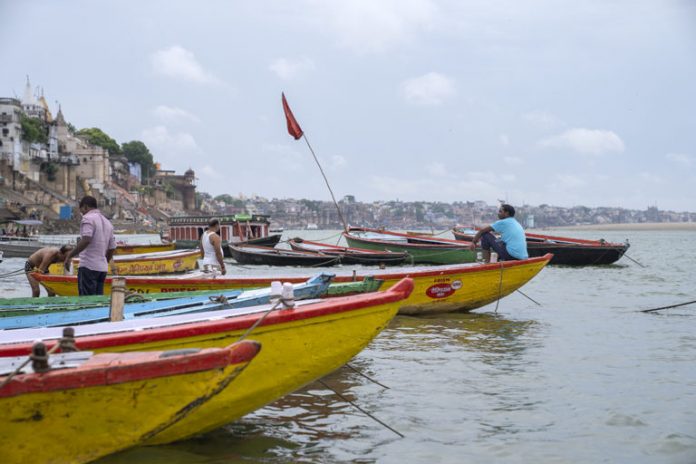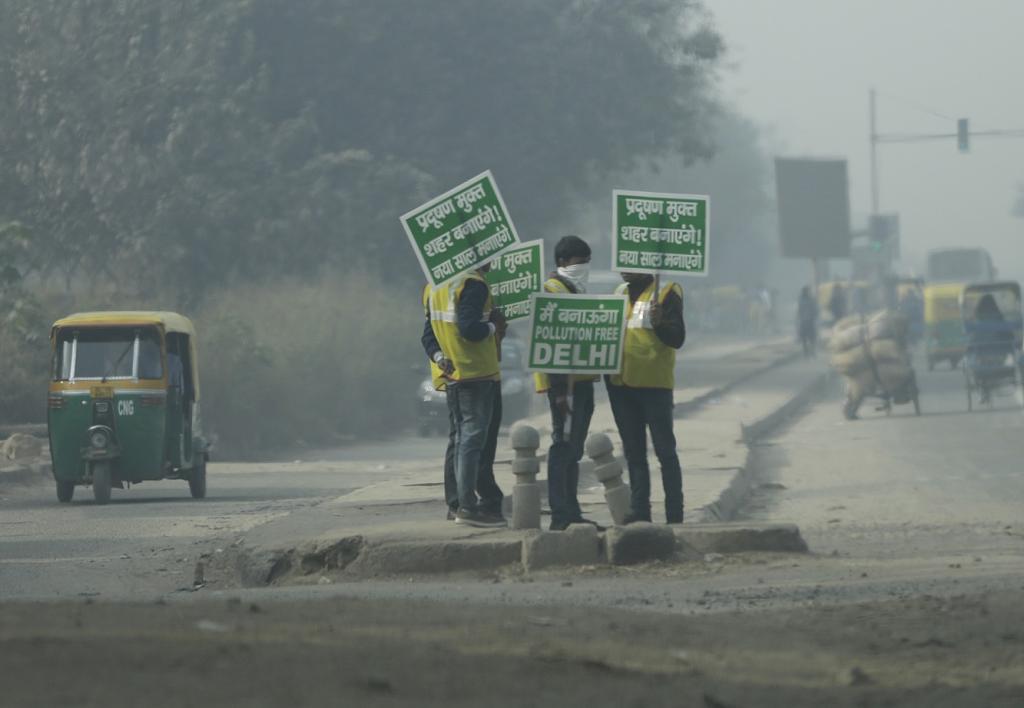
This June marked six years since the government of India launched a Rs. 200 billion (Rs. 20,000 crore) programme, ‘Namami Gange’, for cleaning the severely polluted river Ganga, considered sacred in Hinduism.
Authorities leading the effort to clean the river claim significant improvement in the quality of the river. Those closely monitoring the effort, however, highlight that despite billions of rupees being spent, courts and parliament panels repeatedly pulling up authorities for lax efforts, the river remains polluted with little hope in future as well.
Rajiv Ranjan Mishra, who is the Director-General of the National Mission for Clean Ganga (NMCG), the national body leading the efforts for cleaning the river Ganga, said that over the last few years the Namami Gange programme has had an impact and gathered momentum.
“We have spent around Rs. 10,000 crores (Rs. 100 billion) already from the budget of Rs. 20,000 crores (Rs. 200 billion). Last two to three years great momentum has been built. We have already sanctioned projects of value worth Rs. 28,000 crores (Rs. 280 billion) in different sectors. The results are now visible. But now the programme is not just about cleaning and aims at efforts for improving ecology and flow with conserving biodiversity, ensuring ecological flow and protection of wetlands, springs etc.,” Mishra told Mongabay-India.
“I think we also have followed an evidence-based policymaking system now with scientific mapping and developing baselines on many aspects. We are also focusing on tributaries of rivers Ganga to ensure rejuvenation of Ganga on a long-term basis with a basin approach,” he said, adding that outreach efforts have also been going on.
“We are also focusing on municipal sources of pollution both in urban and rural areas. Projects are being made to tap the drains carrying untreated sewage into the river and divert them to STPs (Sewage Treatment Plants) to prevent polluted flow falling into the river. When we started, against around 3,000 MLD (million litres per day) of sewage generation from Ganga towns, treatment capacity was less than 1,000 MLD and many plants were not functioning well,” said Mishra.
He stressed that the NMCG has scientifically planned for the gap in sewage generation and treatment capacity to take care of requirements upto 2035, estimated to be 3,600 MLD. “We now have treatment capacity exceeding 2,000 MLD which is likely to reach 3,300 MLD in the next two years or so. In Uttarakhand almost entire required capacity has been now created with four STPs in Haridwar (68 MLD), Rishikesh (26 MLD), Muni ki Reti (7.5 and 5 MLD) area getting commissioned during last few months, even during (COVID-19) lockdown period.”
“Similarly, in Kanpur, Prayagraj and Patna as well STPs are being completed. All along 2500 kilometres of Ganga river, sewage capacity is being created. This includes areas like Patna where there was almost no sewage treatment capacity. Moreover, our idea is not to build and forget. We have built-in the operation and maintenance component for 15 years in all our projects. We have moved beyond the construction era and gone into the performance-based era.”
According to the Central Pollution Control Board (CPCB)’s latest available data, the water quality of Ganga across a significant portion of its 2,500 kilometres length is still unfit for bathing and drinking as it does not meet the permissible parameters for biochemical oxygen demand and total coliform.
Vishwambhar Nath Mishra, who is a professor in the department of electronics engineering at the Indian Institute of Technology, Banaras Hindu University (IIT-BHU), remarked that the technology used in the STPs being developed will not bring down the faecal coliform levels which then makes the whole process redundant. “It is because the high faecal coliform level is the root cause for all the waterborne diseases. Another point is that the plan was to intercept the drains falling into the rivers, treat the sewage and then use that water for agriculture etc. However, some of the intercepted drains are falling into another drain which is then again coming to the river and in some cases, the partially treated drain water is again being dumped into the river.”
“The claims being made doesn’t matter but the Ganga river is far from being clean. The tricks that the officials are playing won’t help the river. For instance, often the water quality is recorded in mid-stream areas where water is cleaner. The government claims that the Ganga river has become cleaner. This is all a lie. The river cannot become cleaner till the sewage falling into the river stops completely,” Mishra, who is also the head of the Sankat Mochan Foundation, an NGO to clean and protect the Ganga, told Mongabay-India.
Hits and misses
Prior to the 2014 elections, Prime Minister Narendra Modi had famously claimed the river Ganga as his mother and said that he had come to Varanasi (constituency from where he got elected to parliament) due to her call. Soon after coming into power, the rechristening of the water resources ministry to the ministry of water resources, river development and Ganga rejuvenation and the launch of the Namami Gange programme in June 2014 were among the first few decisions of the Modi government.
Subsequently, in the last six years, the authorities have spent billions of rupees into developing STPs, intercepting drains, tried to bring together states from where Ganga passes before falling into the Bay of Bengal, planned a waterway on the river and a massive afforestation drive, stop people from dumping garbage into the river, development of riverfront and ghats, biodiversity conservation, bioremediation and construction of toilets across gram panchayat near Ganga river etc.
According to the NMCG’s data, a total of 314 projects worth Rs 28,794.27 crore (Rs 287.94 billion) have been sanctioned so far and of that 124 have been completed. It also states that an expenditure of Rs 8,888.19 crore (Rs. 88.88 billion) has been incurred so far (May 31, 2020).
Earlier this year, in March 2020, the Union Minister of State for Jal Shakti and Social Justice and Empowerment, Rattan Lal Kataria, told parliament that a total of 152 sewerage infrastructure projects have been sanctioned in eight states (Uttrakhand, Uttar Pradesh, Bihar, Jharkhand, West Bengal, Delhi, Haryana, Himachal Pradesh) to rehabilitate 4,857 MLD sewage treatment capacities and sewer network of 4,972 kilometres along Ganga and its tributaries. Of that, 46 projects are completed, 75 projects are under progress and 31 projects are under various stages of tendering.
“The completed projects have created 632 MLD sewage treatment capacity and are presently in operation. All the requirements of sewage treatment infrastructure in 10 towns have been fully addressed. These towns contribute almost 64 percent of present sewage generation along Ganga main stem. The towns are: Haridwar, Kanpur, Allahabad, Farrukhabad, Varanasi, Patna, Bhagalpur, Kolkata, Howrah and Bally,” Kataria had said.
Meanwhile, in the 2014-2020 period, environmentalist G.D. Agrawal, popularly known as Swami Gyan Swaroop Sanand, died following a fast of 111 days in demand for a clean and free-flowing Ganga. Agrawal died in October 2018 and in the same month, the central government also published a notification mandating environment flows in the Ganga river, even as it was criticised for having serious flaws.
The plan to clean the polluted Ganga river is not new or exclusive to the current government of India. In the mid-1980s, the then Prime Minister Rajiv Gandhi had launched the Ganga Action Plan to clean the river and since then billions of rupees were spent but the river never got cleaned.

Is there any marked improvement in Ganga’s water quality?
During the past six years, the cleaning of river Ganga has also come under the scanner of the parliamentary standing committee on water resources which, in December 2019, expressed disappointment over the slow pace of Ganga cleaning and pushed the central government to complete all the sanctioned projects under the Namami Gange programme within the scheduled time.
Through a series of orders over the past six years, the National Green Tribunal (NGT) too has been closely monitoring the cleaning process of Ganga. The reports submitted to the NGT by the NMCG and several state governments in compliance with the tribunal’s orders highlight how many drains are still falling into the river and many other areas that still need serious work.
For instance, the NGT in August 2019 had directed completion of all ongoing sewage treatment-related projects by June 2020 end. On this, the NMCG’s report submitted to the NGT on June 26, 2020, states that the progress of sewerage projects has been “severely impacted due to COVID-19 pandemic and the extraordinary situation prevalent in the country.”
“Non-availability of labour at sites and related problems is having a serious impact on the pace of the projects …” said the NMCG. It informed the green tribunal the STPs have been delayed in Bihar “inordinately for want of finalisation of tenders by the state government” and sometimes the reasons “are too trivial.”
The NMCG in its report highlighted that of the five states, Uttarakhand, Uttar Pradesh, Bihar, Jharkhand and West Bengal, the flood plain zoning work is far from being completed except Uttarakhand.
The NMCG also said that based on bio-assessment carried out at 41 locations during 2014-2020, it is found that there is an improvement in biological water quality at 29 of the 41 locations.
On criticism about no visible difference in the quality of the river, NMCG’s Rajiv Ranjan Mishra said he hoped that there is a magical wand. “The projects are in an advanced stage and differences are visible.”
“Did we not see it during Kumbh? Several drains such as Sisamau drain carrying 140 MLD sewage to Ganga at Kanpur is closed. More than 80 drains have been tapped and several more are likely soon. More impact will be visible in future. For example, the entire length of the river is already meeting DO norms. Dolphins and other aquatic animals are also being seen more frequently,” he argued.
Talking about government claims regarding cleaning of Ganga, Vimal Bhai of Matu Jan Sangathan, a Uttarakhand based group that works for community rights, remarked that “everyone has a right to joke.”
“Why I am saying this is because the Bharatiya Janata Party (BJP) leaders exploited Ganga for its political gains and after that just forgot about it. Now they don’t need Ganga and that’s why no one cares about its cleaning anymore. Thousands of crores of rupees (billions) were spent but nothing has changed. The drains are still falling into the river. What is left on the issue of the Ganga river now – Nothing. Dams are also one of the major causes of pollution as it stops the free flow of the river – nirmalta connected with aviralta,” Vimal Bhai told Mongabay-India.
This story was originally published in The Mongabay.













